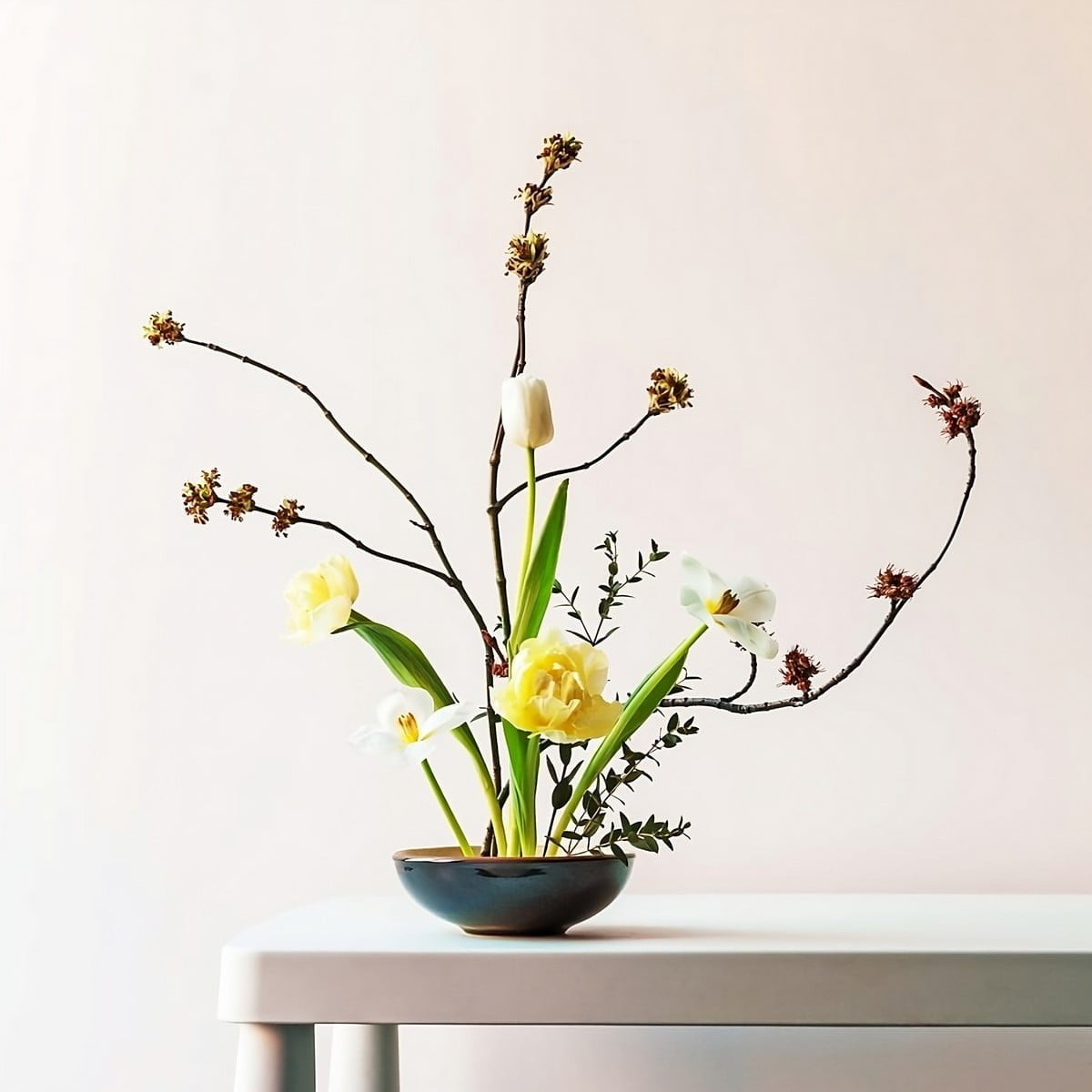Japanese art encompasses a diverse range of styles and media, with a prolific and profound past that dates to as far as the 10th millennium BC (10,000 BCE). Early art forms include ancient pottery and ceramics, origami, sculpture, ink painting and calligraphy on silk and paper, ukiyo-e paintings, woodblock prints, among others. While there are distinctions that emerged, stylistically, from era to era, Japanese art is notably characterized by its use of natural elements and motifs, wealth of symbolism in its imagery and choice of colors, clean lines, overall feel of harmony and balance, and its deep connection to the time-honored philosophies of Zen and wabi-sabi, which evokes beauty in transience and imperfection. Aside from their outward, eye-catching appeal, these art forms typically embody a sublime sense of spirit and soul-soothing aesthetic.
One such expression that simply cannot be overlooked, when it comes to Japanese artistic tradition, is ikebana, the centuries-old custom of arranging flowers. Ikebana, however, is more than a breathtaking bevy of beautiful blooms: it is artistry and spirituality, in equal measure. As with most other genres of Japanese art, there’s more to ikebana than meets the eye.
Japanese art encompasses a diverse range of styles and media, with a prolific and profound past that dates to as far as the 10th millennium BC (10,000 BCE).
Rooted in spiritual practice
The Japanese classical art of flower arranging known as ikebana began to blossom in Japan in the 6th century. Interestingly enough, it is believed to have been introduced in the country by Chinese Buddhist missionaries, in their quest for structure and form to the ritual of offering flowers to Buddha.
There are historians who contend, however, that ikebana’s roots go even deeper, to pre-Buddhist times, when the ancient Japanese would use evergreen trees and flowers to call upon the gods of nature, in early animistic practice. Either way — and while not too much is known about the details and origins of when and how ikebana came about — the custom is rooted in spirituality, as is the case with most other forms of Japanese art.
The evolution of ikebana
From its subtler, more ritualistic beginnings, ikebana evolved into a more defined art form with the opening of Ikenobō (literally, “priest’s residence by a pond”), the first and oldest school of floral art in Japan. Founded in the 7th century by Ono no Imoko — a former Japanese envoy to China, turned Buddhist monk — the school was the very first venue for ikebana’s core style concepts to emerge. At his home by a pond, Ono no Imoko began developing the principles of arrangement for the rikka style of floral setting — a formal, vertically-oriented style employing a typically tall, narrow-mouthed vase — as part of Buddhist ceremony. From this type of fundamental tri-structure arrangement (with branches representing heaven, man, and Earth), the less constrained shoka style emerged. The school likewise gave rise to the concepts of formal (shin), semi-formal (gy), and casual (so) types of arrangement.
Over time, other schools emerged and propagated their respective styles of ikebana, namely Ko or Koryū, Ohara, and Sogetsū. The art of ikebana, as it is known and applied today, reached its first zenith in Japan in the 14th – 16th centuries, during the Muromachi Period, a time of great advancement for Japanese art, in general.
From its subtler, more ritualistic beginnings, ikebana evolved into a more defined art form with the opening of Ikenobō (literally, “priest’s residence by a pond”), the first and oldest school of floral art in Japan.
Living sculptures of serenity
Literally translated, the word ikebana means “living flowers,” while Kadō, another word for the art form, means “way of flowers.” Both meanings convey a wealth of significance: ikebana aims to not only revel in the transient beauty of blooms, but also to express the inner qualities and characteristics of the flowers and other living elements in the arrangement. The art seeks to call attention to elements of nature that people might otherwise ignore. Symbolically, it aims to represent the relationship that exists between divinity, humanity, and the natural world, through its use of the tri-structure arrangement of design elements (usually comprised of flowers, stems, branches, and leaves).
An ikebana arrangement can take anywhere from several minutes to a few hours to make, depending on the intricacy and size of the piece, and on the skill level of the arranger. But, no matter how long it takes, the act of arranging ikebana is meant to be a calming, enlightening experience. The process employs the core concepts of minimalism, asymmetry of balance, harmony, wabi-sabi and the ephemeral qualities of life, the interplay of positive (full) and negative (empty) space to create dimension, and carefully selected colors to achieve a soothing yet dramatic contrast. The resulting pieces are elegant and breathtaking; sculpted, living art whose fragility and impermanence — arrangements last anywhere from two days to two weeks, largely depending on the external conditions — make them all the more brilliant.
While ikebana has been around for centuries, it is once more enjoying a rise in popularity, and has even been hailed as the floral trend of 2023. Despite being diametrically opposed to the western way of arranging flowers, which hinges primarily on filling spaces and on symmetry, ikebana is beloved the world over — for its artistic value, but even more so, for the sense of sublime serenity it lends to any space.






